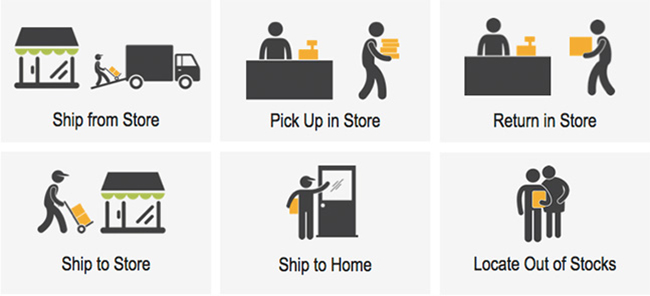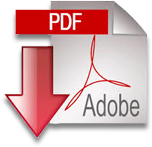Search Results for: Omnichannel
7 Signs You Need an Order Management System
May 12, 2017 by The Bridge Solutions Group Team

High inventory carrying costs can be offset by Ship from Store, which lets you leverage inventory across all your locations, but first you need complete inventory visibility.
S
uccess starts with the right tools to enable your business to grow and thrive. Your eCommerce platform lets you take orders online. An Enterprise Resource Planning (ERP) system helps you manage inventory. Your Warehouse Management System (WMS) lets you manage warehouse tasks efficiently. And if you have retail stores, a Point of Sale (POS) system powers your checkout. So what’s missing?
The system that ties them all together. Not just by joining them (like an Enterprise Service Bus (ESB)) but an intelligent system that optimizes every order. One that lets you provide a superior customer experience so you can delight your customers and inspire repeat purchases. It’s an order management system. Let ‘s look at 7 signs you might need one…
1. Multiple Inventory Locations
Warehouses, stores, third party logistics companies. You could have inventory in many places. But most systems aren’t designed to track inventory across locations. Luckily an order management system excels at this task. It’s designed to integrate with all your other systems and provide you with a single view of inventory across all your locations.
2. In-Store Return of Online Orders is Inefficient or Not Offered
If you have physical stores and an online store, this is key. If you let your customers return online purchases in store, you have an opportunity to convert the return into an exchange. Or sell them something else. It’s a great way to offset the cost of returns. But only if the process is easy and convenient.
3. Unable to Recover from Out of Stocks
Are your stores ever out of stock? That’s lost revenue. But what if your store employees could locate that out of stock item elsewhere? It could be in another store or in a warehouse. Chances are, if you can find it, and either reserve it for your customer or ship it to them, chances are you can save the sale.
4. Inefficient Delivery
If you’re struggling with delivery costs or speed, order management can help. As online orders come in, it routes them to the most optimal location. If speed is important it sends the order to the closest location to the customer (and can enable Ship from Store). If delivery cost is a concern, it routes the order via the cheapest method.
5. High Inventory Carrying Costs
If you can reduce the capital tied up in inventory it can be used for other growth initiatives. There are two ways Order Management can help. It can enable Ship from Store, so you can leverage store inventory to fulfill online orders. Or route orders directly to drop ship vendors so you eliminate inventory handling costs as well. You define the business rules, then Order Management automatically sources inventory from the location with the most inventory or slowest moving inventory. This can also help you minimize markdowns. What does that mean?
6. Too Many Markdowns
Say you get an online order for a shirt. The shirt is generally very popular. But in one store sales are low, which typically means you’ll have to mark it down to move the inventory. But an order management system is smart. Instead of routing the online order to your warehouse, it sends the order to the store with excess inventory. Which means less markdowns.
7. Global Expansion
As you expand globally the ability to route orders from cheapest or fastest location, or from the location that provides the fastest route through customs, is essential. An Order Management system houses the business rules that enable this to happen as each order is placed.
If inventory visibility, omnichannel commerce, or global expansion are part of your growth strategy, let’s talk. We’ll share case studies and consumer data to help you build a business case for Order Management.
Filed under: Blog, Omnichannel, Supply Chain
Is your agency making promises your brand can’t keep?
May 3, 2017 by The Bridge Solutions Group Team

A late delivery damages brand trust. How well do you fulfill orders?
Each year brands spend billions of dollars to entice you to interact with their brand. Armed with a ‘brand goal’ or ‘key consumer insight’, agencies invent unique ways to inspire consumer interaction. Often, they succeed. Brand engagement rises. But can you keep the promises they make? Keep the brand momentum going? Can you deliver well? Is it important?
You bet. In 2016 IBM surveyed 1,500 U.S. consumers on their retail expectations. Results included:
- 59% of customers in their 20s are likely or very likely to not shop with you again if they experience a delayed delivery
- 79% of consumers want easy pickup of online purchases
- 71% of 13-39 year olds want to skip the checkout line
- 63% of 13-39 year olds say Same Day Delivery is important when choosing where to shop
- 96% of consumers say that performance consistency is essential for maintaining trust
The lesson? Protect your brand. Keep your promises. Fulfill orders well.
If you’d like to learn more about fulfillment preferences for your target demographic, schedule a briefing today.
Filed under: Blog, Omnichannel, Supply Chain
Top 9 Order Management Integrations
May 1, 2017 by The Bridge Solutions Group Team

The true power of a distributed order management application comes from the integration of information across multiple channels. While the Sales Order might be the central focus, just as important are inventory visibility, and integration with external services such as tax solutions and credit card processing services.
Below is a list of the 9 most common order management integrations:
- eCommerce Application – Captures online orders from customers. Order management can be used to display inventory availability and shipment status for online orders.
Vendors include: IBM Digital Commerce/Websphere, Magento Commerce, SAP Hybris - ERP/Financial Master – Captures updates to inventory and sales affecting company finances.
Vendors include: SAP, Infor, Epicor - Payment Gateway – Processes credit card transactions.
Vendors include: Cybersource, Chase Paymentech - Warehouse Management System (WMS) – Manages the inventory and process in the warehouse.
Vendors include: JDA, Manhattan Associates, Softeon - Taxation Service – Calculates tax based on the ship to address and final value of the product after discounts.
Vendors include: Avalara - Point of Sales (POS) / Store Application – Manages inventory and payments for cash and carry orders at a store, and allows the order management system to provide in-store inventory availability to online customers, and enable multi-channel returns.
Vendors Include: NCR, Toshiba - Product Information Management (PIM) / Item Master – While most order management systems have their own catalog, as do ERP systems, the PIM provides a more robust item master that can include additional images, video, and other digital content which can be associated with increased conversion rates.
Vendors include: Enterworks - Email Management – While most OMS applications include the capability to email order creation and shipment status information to the customer, most business leverage their existing email tool for this activity to ensure a consistent branded experience.
Vendors include: IBM Watson Campaign Automation, Salesforce Pardot, Oracle Eloqua, Marketo - Parcel Adaptor – Estimate the shipping costs for an order and routes the order to the appropriate carrier so businesses can provide accurate shipping charges to the customer or fulfill using the cheapest delivery method to contain costs.
Vendors include: ProShip, Pitney Bowes Sendsuite, Centiro
There are certainly more Distributed Order Management System integrations, but these are the ones that we see as core. Once you’ve defined your integrations, how do you integrate optimally?
Optimal Integration Considerations
How you integrate depends on many factors, but you may want to consider the following:
- Will my integration vendors ever change? If so, you may want to consider using an Enterprise Service Bus (ESB) for ease of long term integration management.
- Which system should be my item master?
- How often should different systems update each other (batch, trickle feeds, etc.)?
If you’re not sure of the best order management integration strategy for your business, we’d be happy to conduct an Order Management Integration Assessment. Simply complete the form below.
Filed under: Blog, Omnichannel, Supply Chain
The Store: A Critical Omni-Channel Component
November 3, 2016 by The Bridge Solutions Group Team

While eCommerce is expanding the store is still a critical part of your omni-channel strategy.
Ask us about a briefing on the IBM Consumer Expectations Study 2016 to learn more.
What does it really take to be an omni-channel organization? Regardless, if it is retail, manufacturing, wholesale, or B2B, omni-channel retail has four critical requirements: Read More…
Filed under: Blog, Omnichannel, Supply Chain
Delivering Merchandise: The Hard Facts
August 22, 2016 by The Bridge Solutions Group Team

The 13-39 year old group have the highest delivery expectations of all consumers.
Retailers are suffering from customer delivery expectations. The customer wants their order completed the fastest and cheapest way. Studying the trends since 2010, we have found that those in the 13-39 year old group have the highest expectations of all. Read More…
Filed under: Blog, Omnichannel, Supply Chain
46 reasons you need Distributed Order Management (DOM)
May 24, 2016 by The Bridge Solutions Group Team

If you’re not sure if Distributed Order Management is right for you, or you’re struggling to justify a budget for Distributed Order Management implementation, here are 46 reasons why developing a Distributed Order Management business case is worth it: Read More…
Filed under: Blog, Omnichannel, Supply Chain
Omni-Channel Retail: An Appointment to sell
April 8, 2016 by The Bridge Solutions Group Team

Are your store associates ready to maximize the value of a Buy Online Pickup In Store customer?
At Bridge Solutions Group, we’ve noticed a distinct change of late. No longer are our clients asking us why they should become “Omni-Channel”, the conversation is now invariably about how they should transition to an Omni-Channel model and what capabilities can enhance their consumers experience and provide a competitive advantage.
So in this the first of a series of articles we will explore some strategies and tactics that will enhance your brand and your top and bottom line as well.
Filed under: Blog, Omnichannel, Supply Chain
Omni-Channel Fulfillment: 5 metrics to include in your business case
October 8, 2015 by The Bridge Solutions Group Team

Are you building a business case for omni-channel fulfillment? Here are some metrics that can help you.
ONE
72% of customers would purchase an out-of-stock item if an associate could locate the item and find a way to get it to them. Read More…
Filed under: Blog, Omnichannel, Supply Chain
Robots are coming to a retailer near you!
September 25, 2015 by The Bridge Solutions Group Team
A Robot in one of Lowe’s Orchard Supply stores. Source: YouTube/Orchard Supply Hardware
In 1946, Ford Motor Company was using automation in the form of robots. Specifically to perform single tasks such as stamping out fenders. But, robots have come a long way!
Microchips are more sophisticated. Robots today can complete almost any task. Machines use numerically controlled technology, derived from computers, to control motions and actions based on predetermined programs. They have the ability to respond, discuss, lead and solve. They’re smart! And now robots are being tested for in store customer engagements. Read More…
Filed under: Blog, Omnichannel, Supply Chain

 For FREE insights into how to improve your supply chain, simply enter your contact information for access to our entire library of eBooks, whitepapers and data sheets.
For FREE insights into how to improve your supply chain, simply enter your contact information for access to our entire library of eBooks, whitepapers and data sheets. You'll be missing out on access to hundreds of pages of supply chain industry ideas and insights that will make you look great in your next meeting.
You'll be missing out on access to hundreds of pages of supply chain industry ideas and insights that will make you look great in your next meeting.